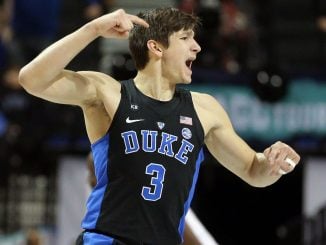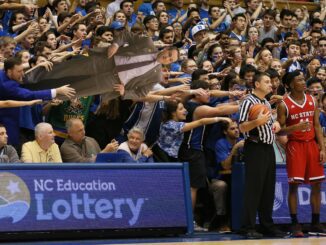
They’re not exactly the Fab Five — none were five-star recruits or even freshmen.
It can be argued, however, that in their own way, the five transfers brought in this season by Wake Forest coach Steve Forbes have had as profound an effect on the Deacons’ fortunes as Chris Webber, Jalen Rose and their heralded teammates had on Michigan in the early 1990s.
Their arrival has transformed a program that won just six games last year and has enjoyed only one winning season in the past decade into one of the surprise teams of 2021-22. With its rout of Boston College on Monday, Wake improved to 17-4 overall, 6-3 in the ACC.
Welcome to the transfer portal era that has, for all intents and purposes, brought free agency to college basketball.
Forbes is hardly the only coach in the country to take advantage of the new rules that allow players one free opportunity to move from one school to another without having to sit out a season. Every team in the ACC this year has at least one veteran newcomer on its roster.
By adding Alondes Williams from Oklahoma, Jake LaRavia from Indiana State, Dallas Walton from Colorado, Khadim Sy from Ole Miss and Damari Monsanto from East Tennessee State, Forbes has simply done it better than most.
“I think it comes down to recruiting,” Forbes said. “You try to do the best you can. Recruiting is not a perfect science at all, and you don’t really know something about any player until you put them in an adverse situation. And you’re not going to really see them in adversity when you recruit them, especially when you’re only doing it on Zoom.”
Forbes speaks from experience on the hit-or-miss nature of recruiting off the transfer portal.
His first Deacons team also featured five new additions, but things didn’t work out quite as well as the current edition. Of that group, only Daivien Williamson is still in the program. And he was originally recruited to East Tennessee State by Forbes.
Because the pursuit of transfers is based more on need and immediate production than it is with high school seniors, recruiting off the portal is a much different proposition than the traditional version.
“It’s not just the physical abilities of a transfer, it’s what else are they?” said Duke’s Mike Krzyzewski.
“It always has to be a fit,” added NC State coach Kevin Keatts. “I’m not just saying from a basketball standpoint. Personalities have to blend, you’ve got to make sure that a young man can come into your program and not disrupt.
“Every transfer is not for everyone. Doing your homework on guys, you’ve got to make sure they can fit the school academically. Socially, will they survive in this area? And then from a basketball standpoint, are they capable of playing in our system?”
Like Wake Forest, each of the state’s three other ACC schools has blended transfers into their lineups. With varying degrees of success.
At North Carolina, power forward Brady Manek from Oklahoma has been a major contributor to the Tar Heels, but Marquette big man Dawson Garcia has cooled off after a strong start and Virginia wing Justin McKoy is averaging a shade over eight minutes and 1.5 points per game.
Another Virginia refugee, guard Casey Morsell, is a starter for NC State, but Providence wing Greg Gantt has yet to play for the Wolfpack because of a preseason injury.
Duke, meanwhile, has gotten productive minutes off the bench from Marquette big Theo John, while Davidson guard Bates Jones is a deep reserve.
In all, 1,573 players nationally entered the transfer portal after last season. Thirty-four of them landed in the ACC this season.
“I was looking at something the other day, and our transfers in this league have been very, very successful,” Keatts said. “I think that’s a good sign for the coaches who are recruiting in this league because it feels like everybody is recruiting guys that fit their system and are not chemistry killers.
“I think it’s important to do your homework and you’re getting somebody that is bringing something positive to your team.”
While State, Wake and UNC have included experienced players with multiple seasons of eligibility remaining in their most recent classes, Duke — in Krzyzewski’s final season as the Blue Devils’ coach — has stuck strictly to graduate students, the transfer portal equivalent of one-and-done players.
“We had eight good players returning or coming in and we wanted to show our commitment to them,” Krzyzewski said. “I also didn’t want to mess up future recruiting. I think we wouldn’t have the (2022) recruiting year we’re having if you had loaded up with transfers. … I think we stayed the course and it’s worked out well this year.”
Regardless of how many transfers are added or how much eligibility they have remaining, the new rules that allow them to play right away have made integrating them into their new programs more of a challenge.
“A lot of times it depends on the individual,” said Keatts, who has had at least one transfer on his roster in each of his five seasons with the Wolfpack. “Some guys can obviously pick up on the system quick and they become part of your chemistry quick. Sometimes it takes guys a little longer.”



